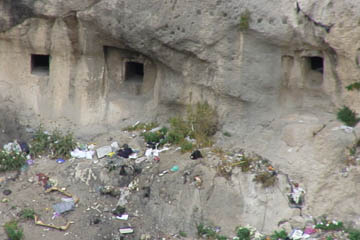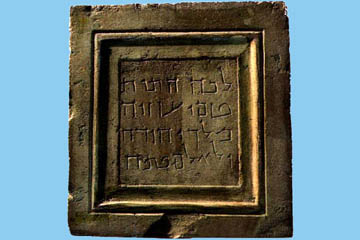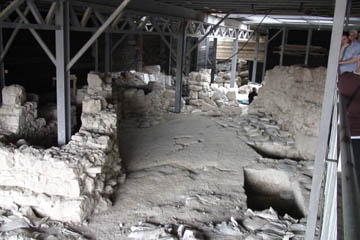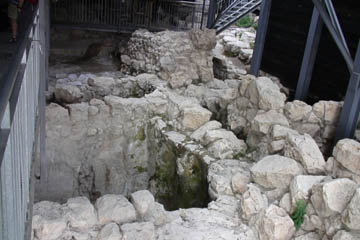David's Palace?
When I arrived in Israel this year (2009) my first act on reaching Jerusalem was to go into the tourist information centre just inside the Jaffa Gate - I was passing that way anyway - and enquire about the precise location of the palace recently discovered by Eilat Mazar. There was a period of incomprehension - tourist office staff the world over appear to be chosen for their youth and good looks rather than intelligence - but eventually she looked up the computer on her desk and told me that it was in the "City of David" excavations and even helpfully showed me on a map where these excavations were.
I thanked her somewhat perfunctorily, as I knew very well where the "City of David" excavations were and was sure that Eilat's dig had been somewhere else. I now have to apologise to her, as we were both right: the dig was not in the area that I knew of as the "City of David excavations", but it was within the boundaries of the new "City of David" exhibition and excavation.
In due course I made my way out the Dung Gate and headed down the road that runs along the spine of Mt Ophel. On the right was a very colourful fence which turned out to have some quite interesting information painted on it, including the fact that the spoil from the construction work on the Temple Mount - an egregious bit of vandalism by the Waqf, the Muslim authorities in charge of the Haram - is now being painstakingly sifted by volunteers who have made some interesting finds, though doubtless the best bits went into the construction workers' pockets and is now being sold through clandestine channels in the antiquities market.
I took a few photographs from whatever holes I could find in the fence, as there was archaeological work going on down behind it, though what is being dug up or what has been or may be found I have no idea, nor was there anyone I could ask, nor any information on the fence. The hole is deep enough and big enough to count as possibly the largest excavation undertaken in ancient Jerusalem, so it is a pity the archaeologists are not more forthcoming with information.

|
| Several tombs in the hillside of Silwan. They could have been covered by a lid like the one opposite. |
However the hole did not correspond with the little I knew about Eilat Mazar's dig, but a little scouting up and down the opposite side of the road didn't reveal anything that might be it either, so at lenth I ventured into through the gateway marked "City of David". A path on the left led up to a viewpoint from which I could look down on the village of Silwan and see some of the tombs which lie within its boundaries. The Jews are in the process of expropriating houses in the village and filling them with Jews - an unust proceeding that ordinarily would have me protesting loudly, but I fear that in the case of Silwan I find it easy to refrain. I have never ventured into the village or along the valley floor beneath it without being stoned or abused by small boys, so I view the extirpation of the Arab village with equanimity.

|
| The inscription from the tomb of Uzziah. It reads, 'Here are the bones of Uzziah king of Judah. Do not open.' |
(A note to both sides: if you want to win the propaganda war, you don't do it by being nasty to visitors. Invest in a copy of Dale Carneigie's How to Win Friends and Influence People and put its precepts into practice.)
When I came down from the viewpoint I turned to the right and went down some steps to the ticket office. The floor on which I stood was a sort of metal grid, the sort of thing that forms the landings in external fire escapes, and beneath it I could vaguely glimpse a jumble of ruins. It turned out that this was where one purchased tickets for the Warren Shaft and Hezekiah's Tunnel, both a hundred or so steps beneath us on the slopes of the Ophel. However the girl behind the counter was most helpful when I enquired where Eilat Mazar had been working.
"Go down the steps behind you," she instructed, "and it's there."
I turned and observed, for the first time, that about twenty feet away and opposite the ticket office there was a metal staircase descending through the metal deck. I thanked the girl and went over to the steps. They led down to a metal pathway that allowed you to walk above the ruins and view them.
At the foot of the stairs there was a party of Jewish school children being harangued by an adult - a teacher? - who, as I arrived, was telling them the story of David. I couldn't help overhearing as he informed the children, "When David went to fight Goliath, he was acting as the representative of Ha-Shem and whether you like it or not, you are all also representatives of Ha Shem." I trust the assembled children will remember the statement - which I wholeheartedly endorse, by the way - and remember that they are representing God to the Palestinians as much as to anyone else.

|
| This may be the entrance to the 'palace'. Notice the walls on either side as well as the natural rock floor. |
It was just as well this gentleman was there, as otherwise there was no sign or indication that I had arrived at what Eilat claims is the palace of David. There were no information boards to help make sense of the jumble of cisterns, walls, mysterious conical holes in the rock, and rock pavements. About all I can say is that whatever it was, it was probably a quite large building with more than one floor, judging by the size of the walls.

|
| A large cistern which may have supplied water to the palace. Notice the stairs in the background coming down from the ticket office. |
Of course, Eilat was basing her claim on more than just the walls. Among the finds were a fragment of a copper scroll, pottery from the Iron II period, and, most significant of all, a bulla, or seal impression, naming Jehucal, son of Shelemiah, son of Shevi, an official who is mentioned at least twice in the Book of Jeremiah. Three years later her team found a second bulla, this time inscribed with the name of Gedaliah ben Pashur, who is mentioned in Jeremiah 38:1 along with Jehucal.
Needless to say, her discovery has been attacked by Israel Finkelstein and others from his "minimalist school", who have previously gone on record to claim to David was little more than a village headman and that nothing significant from his period had ever been found (true) and - by implication - never would be (not only false but foolish!) If Eilat's interpretation of her discovery is vindicated, then Finkelstein and his colleauges will be left with considerable quantities of egg on their faces and will have to rewrite the books they have so triumphantly published.
Unfortunately Eilat rather put herself in the hands of her critics when she found a seal and without thinking read it as "Tamach". The problem lies in the fact that she temporarily forgot that seals are designed to give a right-way-round picture and inscription when pressed into clay, so the picture and the inscription is necessarily the wrong-way-round on the seal! The correct reading is, in fact, "Shelomith", as she has herself now admitted. This mistake has made it easier for critics to find fault with all her discoveries and their interpretation.
A second problem is that the dig was financed, not by the Israeli Department of Antiquities but by the Shalem Centre, a right-wing organisation that promotes Zionism. Despite claiming to be impartial, many suspect that the Centre is, in fact, highly partisan and suggest that the interpretation of Eilat's finds has been influenced by the Zionist agenda.
Amihai Mazar, one of Israel's leading archaeologists and a cousin to Eilat Mazar, has pointed to the fact that no floor was found in the building, which makes it impossible to date it accurately by stratigraphic methods. It is clearly post-Iron Age I, but it may even be post-Iron Age II and the seal and seal impressions may either be of individuals with the same names as Bible characters but not those characters themselves, or they may be completely unrelated to the building, which was erected over the debris which included the seals.
In short, although the find is a significant one, until the nearby houses can be purchased and demolished, allowing excavations to be carried out over a larger area, it is impossible to be sure exactly how the find should be interpreted. Personally, I doubt that it is the palace of David. By the revised chronology which we espouse here, David should be in the later part of the Middle Bronze or even the Late Bronze, but certainly not in the Iron Age.
Nevertheless, I was most interested to see the ruins and have no doubt that Eilat Mazar is an archaeologist to watch, particularly if she manages to demolish the nearby buildings - and with the backing of the Salem Foundation, it is quite possible that that may happen sooner than many people expect.
Ha-Shem The same perverse logic which causes a Jew to spell "God" as "G-d" leads him to say "Ha-Shem" - The Name - instead of "God". It is supposed to be an act of reverence, as just in case you are referring to God in an inappropriate way, you can fool Him into overlooking the offence by saying "The Name", because God is presumably too dim-witted to realise whom you are talking about. Return
revised chronology Other articles on this site explain why we believe that the Exodus took place at the end of Early Bronze and the early Israelite period should be identified with MBI or, as some call it, EB/MB. However study still continues on where we should put David and Solomon and the divided kingdom which followed them. The founder of Diggings places them in Middle Bronze and sees the Late Bronze as the period of the Exile. Personally I cannot agree with that: there are too many finds from the Iron Ages, particularly Iron II, which link with the Israelite kings. These include seal impressions naming kings or their officials known from the Bible, as well as the destruction layers that can be associated with the Assyrians.
In my opinion, therefore, Eilat's Iron II palace may be associated with the later kings of Judah, such as Hezekiah or Jehoiakim, but is too late to be linked with either David or Solomon. Return
© Kendall K. Down 2009





